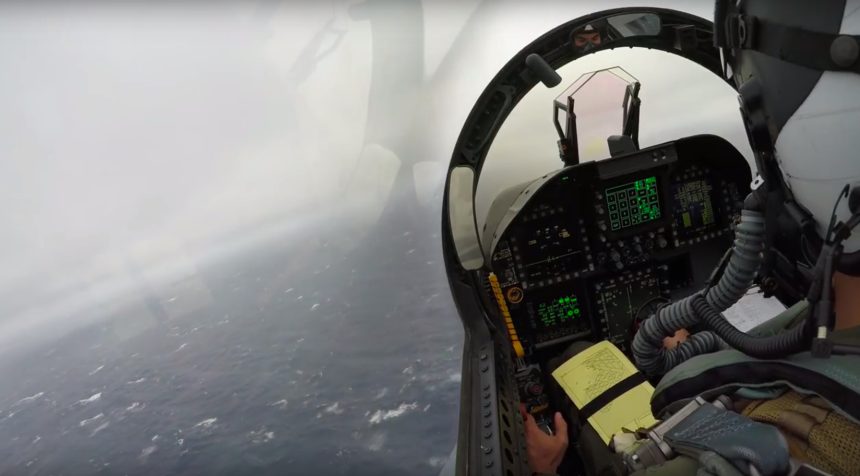Check out what happens inside the cockpit of a VFA-143 “Rhino” performing a Case II recovery procedure.
The footage below shows a recovery to the carrier in low visibility conditions of a Super Hornet (or “Rhino” as the aircraft is nicknamed aboard supercarriers) with the VFA-143 “Pukin Dogs” (based on the badge that can be seen on the pilot’s flight helmet).
Not as scary as a night landing, still quite interesting, considered that you can almost read the instruments and see all what the pilot does during the approach.
As explained before here at The Aviationist, all aircraft returning to the carrier have to enter the Carrier Control Aerea, a circular airspace within a radius of 50 nautical miles around the carrier, extending upward from the surface to infinity. Within the CCA, all traffic is usually controlled by the CATCC (Carrier Air Traffic Control Center) and inbound flights are normally in radio contact with the “marshal control” who radios clearances within the marshal pattern.
The actual procedure for holding and landing depends on the weather conditions.
Under Case I recovery (meaning more or less “good weather”, with ceiling of at least 3,000 feet and 5 miles visibility within the carrier control zone – a circular airspace within 5 miles horizontal radius from the carrier, extending upwar from the surface to 2,500 feet) the traffics wait their turn for final approach to landing circling in a holding pattern.
Case-II approaches are used when weather conditions are such that the flight may encounter instrument conditions during the descent, but visual conditions of at least 1,000 feet (300 m) ceiling and 5 nautical miles (9.3 km; 5.8 mi) visibility exist at the ship. Positive radar control is used until the pilot is inside 10 nautical miles (19 km; 12 mi) and reports the ship in sight.
According to the NATOPS manual, under Case-II conditions: “Penetrations in actual instrument conditions by formation flights of more than two aircraft are not authorized. Flight leaders shall follow Case III approach procedures outside of 10 nm. When within 10 nm with the ship in sight, flights will be shifted to tower control and pro- ceed as in Case I. If the flight does not have the ship in sight at 10 nm, the flight may descend to not less than 800 feet. If a flight does not have the ship in sight at 5 miles, both aircraft shall be vectored into the bolter/waveoff pattern and action taken to conduct a Case III recovery for the remaining flights.”
For jets and turboprops the holding pattern is a left-hand pattern more or less tangent to the BRC (Base Recovery Course – magnetic heading of the ship) with the ship in the 3-o’clock position and a maximum diameter of 5 nm.
Aircraft circle at altitudes from 2,000 feet upward at various levels with a vertical separation of 1,000 feet.
Once the flight deck is free for landings, the lowest aircraft in the “stack”, leave its altitude to enter the landing pattern while the flights above, one by one, descend to the lower level vacated by the preceding flight.
In accordance with the EAT (Expected Approach Time) the aircraft depart the holding in such a way to reach the ‘”initial”, 3 miles astern at 800 feet altitude. Thereafter a “break” and a subsequent spin pattern is flown at 1,200 feet within 3 nm of the ship.
Aircraft in the landing pattern, properly separated (no more than 6 at any given time), continue to fly the downwind at 600 feet, perform base turn and align with the ship, astern at about 350 to 400 feet.
From there the Improved Fresnel Lens Optical Landing System (IFLOLS) lights provide the pilot with a visual indication of proper approach path.
[Read also: All you need to know about arrested landings on U.S. aircraft carriers]
Enjoy the video.








